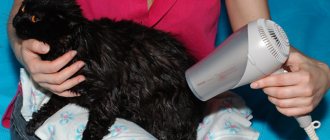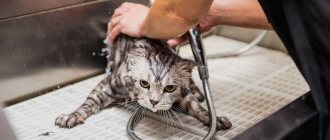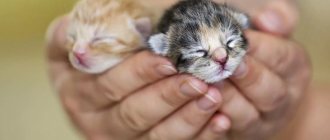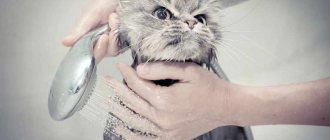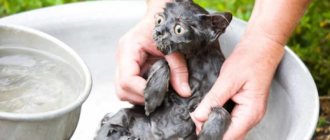Compliance with the rules of pet hygiene is the key to its health. Despite the fact that cats are one of the cleanest animals, it is necessary to carry out water procedures periodically.
It is most important to wash your cat if it has access to the outdoors. During a walk, the fur collects dust, in addition, the pet can become infected with something through spoiled food, dirt and contact with other animals.
When should you wash your cat?
Cats themselves are clean animals, but despite this, experts recommend washing them in the following cases:
- heavy pollution, for example, after walking outside;
- formation of tangles;
- dullness and loss of shine of wool;
- treatment for various parasitic and infectious diseases, as well as allergic reactions using specialized means;
- participation in the exhibition - the animal is bathed using professional cosmetics to make the coat shiny and thick;
- scheduled haircut at the groomer;
- if for some reason the animal is forced to go to the toilet in diapers, you should approach the procedure carefully, since bathing can lead to a worsening of the current disease, so you should consult a veterinarian before carrying out the procedure.
It is worth keeping in mind that many cats are afraid of water. And this is quite natural. Apart from the fact that a wet cat is cold, in this form it is completely helpless, its smell is distinct, and therefore enemies can attack, because the cat is a real predator. We recommend reading the article why cats are afraid of water and what to do about it. To accustom an animal to bathing, experts recommend doing the first one at an early age. It is more difficult to accustom an adult pet to water. In addition, it is important to create comfortable conditions: exclude loud sounds, do everything gradually. Afterwards, for persistence, you should offer the cat a treat or a toy.
Is it possible to do without swimming?
Cats are naturally afraid of water, so washing your pet often means exposing it to stress. In addition, these animals are truly endowed with the ability to care for themselves. They have a rough tongue that allows the pet to thoroughly clean the fur, and they wash hard-to-reach places with their paws. Despite this, even domestic cats need to be washed, and there are a number of reasons for this:
- seasonal shedding, when the animal loses hair in large quantities;
- unexpected contamination that greatly interferes with the animal’s comfort or appearance;
- The cat became infected with parasites.
In the case of shedding, hair ingested by a pet can cause intestinal blockage. But it cannot be said that bathing a cat will help avoid such a problem. It is best not to neglect combing the fur with a furminator - a special comb for cats. This will ensure the safety of both the physical and mental health of the animal.
If your pet has contracted parasites, you cannot rely on its natural cleanliness. In this situation, human help is needed. And unwanted inhabitants on a cat’s body will bring him much more discomfort than water.
A pet that has gotten dirty with dirt, paint or something similar can clean itself up on its own, but this is not always safe. Some substances that cats get dirty in are harmful to their health. The animal, while licking itself, swallows the pollution, and this leads to poisoning, intestinal diseases or other unpleasant consequences. Therefore, if your furry friend gets into something, it is advisable to first check whether he can harm himself. If so, you will have to bathe the cat immediately. When everything is not so scary, you can let your pet take care of personal hygiene on its own.
How often can you wash a kitten and cat?
Kittens under one year old should not be washed frequently, no more than once a month. If your baby has a bad day and gets dirty, wash only the dirty area, be it paws, butt, etc. If necessary, simply wipe the rest of the wool with a damp sponge.
An adult cat should not be washed unnecessarily more than once every three months during the cold season (i.e., once each in autumn and winter, maximum); in spring and summer, you can wash it a total of four times. However, it should be taken into account that the number of water procedures depends, among other things, on the breed of the animal (length of fur), conditions of detention, and habitat. Thus, cats that do not have hair are bathed much more often than long- or short-haired cats, namely once every two weeks in the summer, and once a month in the winter. Pets are washed more often if they live in large cities, near a highway, or in an environmentally unfavorable area.
Where to go in Moscow?
- Fluffy happiness. Addresses:
- N. Cheryomushki, st. Garibaldi, 15.
- st. Kastanaevskaya, 17.
In addition to highly qualified groomers, a veterinary office is open here twice a week. There is a large selection of accessories, clothing and pet comfort products.
- Chain of pet salons Baluti.
Addresses of pet salons:
- M. Kuntsevo, Kastanaevskaya, 58.
- m. Marksistskaya, Ryazansky Ave.
- m. Varshavskaya.
- m. Tulskaya.
- m. Shchelkovskaya.
In salons there are discounts on services for kittens, check with the administrator. There is also a late appointment for busy people, but be careful, the cost of procedures will be increased by 50%.
In addition, there is a service to call a master groomer to your home. If you have a long-haired cat, you can handle it yourself - just read our article .
Watch the video: MY CAT - See how to do it correctly
When to bathe a kitten for the first time
If you bought a kitten, you don’t need to immediately run to bathe it. Moving to a new house is already stressful for a baby, but here you are with your own shower and shampoos. It's better not to touch it for several months. But if a kitten is found on the street, then it needs to not only be washed, but also treated for external parasites, worms, and taken to a veterinarian.
If the baby is less than three months old, it only needs to be combed, you can wipe it with a wet sponge. If the kitten is purebred and you plan to participate in exhibitions, then bathing can begin at 3-4 months. In this case, it is important to start early, since show-class animals must be accustomed to all kinds of procedures and need to live with them.
If it didn’t work out on your own
If your pet is significantly dirty, does not allow itself to be washed, burdock or other debris is tangled in its fur, and you cannot cope on your own, then you should not torture yourself and your pet.
There are grooming salons for professional hygiene procedures. This is, one might say, a hairdressing salon for animals. If there is no such thing nearby, then you can contact a veterinary clinic.
ON A NOTE! In addition, there are groomers who work from home : they simply come to your apartment and cut the animal on the spot. It’s convenient to work with such a professional - you don’t have to travel anywhere, and the cat will be in comfortable conditions.
What you need to know when bathing a kitten for the first time
So, the rules for the first bath:
- The kitten should be cheerful and cheerful.
- Not hungry, but not just eaten.
- The room should be warm.
In what cases should you avoid swimming:
- Less than two weeks have passed since vaccinations or treatment against external parasites.
- Having recently been spayed or neutered, it is better not to bathe the cat for at least two more months.
- With a large amount of discharge from the ears or eyes.
Don't wake up your baby and immediately put him in the bath. First, play with him, he should be cheerful.
Drying wool after bathing
After washing, take a towel and gently blot the animal's fur with it. Wring it out, wrap the cat in a towel and wipe with light massaging movements. When it gets very wet, take another dry towel and wrap your pet in it.
After this, the cat can be taken out of the bath and placed on a dry towel. Make sure that the balcony and windows are closed. If the cat has long hair, you can brush the fur until it dries. The procedure will not only speed up drying, but will also make it easy to get rid of knots if they appeared during the washing process. It is better not to use a hairdryer.
Praise the cat
After bathing, be sure to praise the cat, pet him, and tell him how good he is. Give a favorite treat, catnip, or another treat that you rarely give on special occasions. If your cat associates washing with a reward, he will be more willing to bathe.
How to prepare a cat for a bath
Before carrying out the procedure, it is necessary to prepare the work space: place shampoo and a large terry towel within easy reach. You should also set a comfortable water temperature - about 39 degrees. Under no circumstances should you wash your pet in cold or hot water.
To reduce the noise produced by water, you should first fill the bath with a small amount of water and also reduce the shower pressure, in which case the cat will experience less stress and will tolerate bathing better. The ideal option is to stop using the shower. To do this, you need to prepare a sufficient amount of warm water and a ladle or small saucepan with which you can water your pet.
About one day before the planned bathing, it is recommended to comb your pet thoroughly so that if water gets in, lumps and tangled strands do not form.
If the cat is about to have its first bath, it is necessary to calm it down and avoid loud noises and screams that could frighten it. It is also recommended to carry out the procedure together - one person holds it, the other washes it.
It is recommended to place a rubber mat or terry towel at the bottom of the bath to prevent the cat from slipping on it.
Before placing the cat in the bathroom, shampoo is poured into a specially designated container and diluted in water to form abundant foam.
How to wash a cat if she is afraid of water
Many cats are terrified of water due to natural features and due to the owner’s incorrect approach to bathing. Since sooner or later you will have to bathe a cat that is afraid of water, you need to learn a few simple tricks. If you follow them, even the most nervous cat will eventually get used to the water and stop throwing “tantrums” while bathing.
The water temperature should be comfortable. For cats this is approximately 35-37 degrees, and for sphinxes - all 40.
It is extremely important to gradually lower the cat into the water. You can start by wetting one paw at a time, while simultaneously holding him so that he cannot move the rest freely.
There should be no sound of water in the room, as some cats are more afraid of it than the water itself. To do this, you need to prepare all the water for washing and turn off the tap.
It is important to calmly talk to your pet during and after the procedure, praise and support it. Animals subtly sense the psychological state of the owner, his tone, care - and they themselves calm down.
At the bottom of the basin or bathtub where the cat will be bathed, it is necessary to place a special rubber mat to prevent the paws from slipping, which can cause panic in the cat.
If the cat strongly resists and it is absolutely impossible to wash it without injury, you need to purchase a special mesh bag for bathing. It will secure the animal’s limbs, preventing it from getting out, scratching and “rowing”, and the structure of the mesh will allow you to easily apply shampoo and rinse off the foam with water.
Another way is to enlist the help of a member of your household. One person will hold the cat, and the second will lather and rinse off the foam. This will make the animal feel more stable in the water and prevent it from scratching you.
The third option is quite unusual, but can also work: take a bath with your pet. Put on a T-shirt and shorts that you don't mind, and go into the water with your cat in your arms. Many pets, seeing that the owner is sitting nearby, calm down and accept the washing procedure much better. In this case, bathing the cat can also be done with an assistant - he will take the clean animal in a towel and help if necessary.
Mr. Cat recommends: what products to use to bathe a cat
In order not to harm the condition of your pet’s fur and skin, you need to choose the right shampoo.
- Shampoo is available for oily and dry skin. In the latter case, they reduce the formation of static, add shine, and nourish. Some products contain sebum, that is, a fat-like substance that is secreted by the sebaceous glands, as a result of which the coat is covered with a protective layer. If your pet has oily skin, shampoo helps remove excess oil.
- If your pet has unkempt fur, you should choose a shampoo to remove tangles. The mechanism of action is that positively charged components come into contact with negatively charged hairs, causing the clumps to unravel. The product also gives a healthy shine and elasticity to the coat.
- Tinting shampoo is usually used in preparation for an exhibition to give the coat a pronounced shine and deepen the color. Such products contain coloring pigments that interact unstable with the hair, due to which they are gradually washed off from the pet’s fur. The use of such shampoos for bathing spotted cats is not recommended, as the white areas of the coat may lose their color.
- Lightening agent is used to whiten stains. Most often used before an exhibition.
- A special shampoo for breeds without hair, designed for high-quality skin care. Such products are presented in small quantities on the domestic market, and are also high in cost, so they can be replaced with children's hypoallergenic shampoo.
- Specialized medicinal shampoos are prescribed by a veterinarian to treat skin infections, treat fleas and lice.
For cats that really don’t like to wash themselves, spray or dry shampoos have been created. It is enough to spray them on the wool, and after a few minutes comb it.
Cat bath products are used according to the instructions; if side effects occur or if the contents get into the eyes, ears or nose, you should contact a veterinarian.
Where to go in St. Petersburg?
- MasterGroom chain of salons.
Addresses of pet salons:
- Degtyarny lane, house 20.
- Kondratyevsky Prospekt, house 64, building 2.
- Bolshevikov Avenue, house 38, building 5.
- Yuri Gagarin Avenue, 14, building 6.
- Listvennaya street, building 18, building 1.
There are discounts in salons. Meeting the master 10%, writing a review 5%.
- Salon Fox. In the market of pet products and services for more than 12 years. In addition to grooming, there is a veterinary pharmacy and a large selection of hygiene products for caring for your pet’s skin and coat.
Addresses of pet salons:
- st. Communes no. 59 (Krasnogvardeisky district, on the territory of Rzhevka).
- st. Leningradskaya 7 (Novy Okkervil microdistrict, Vsevolozhsky district, Kudrovo village).
Features of washing different breeds
Sphynx cats do not have hair, as a result of which their skin is prone to excessive oil production, so it is recommended to bathe cats of this breed more often than others - from 7-9 times a year to once every 2-6 weeks. Between baths, you can wipe your skin with damp hypoallergenic wipes.
You can understand whether a hairless cat needs to be washed by the following signs:
- unpleasant odor;
- fatty deposits on the skin, stickiness;
- dirt in the folds.
Long-haired and semi-long-haired breeds require less frequent bathing. So, Persians and Sibiryaks are bathed once every 1.5-2 months, or even less often. It is recommended to use a shampoo depending on your skin type, as well as a conditioner that prevents the formation of tangles.
Short-haired cats, such as Britons, Scots, Bengals, etc., do not need to be bathed at all, but in general it is better to do this unless absolutely necessary, no more than once every 4-6 months.
1111
Tar soap for fleas in cats: how to use?
Tar soap based on birch tar contains natural substances that have disinfestant properties. It is believed that it can remove fleas from cats.
Tar soap is used against fleas on cats.
IMPORTANT: Yes, tar soap against fleas helps, but the procedure will have to be carried out several times, perhaps a lot. The soap solution washes out or kills fleas, but not their eggs. Frequent bathing is harmful for cats; it is preferable to use modern means that get rid of fleas in 1-2 applications.
If you still decide to remove fleas from a cat with tar soap, it is done like this:
- Prepare a soap solution. 0.25 soap is grated and completely dissolved in 200 ml of warm water.
- Moisten the cat's fur with regular warm water.
- Treat the wool with a solution of tar soap so that it gets on the skin. Thoroughly wash the folds of the paws, under the tail, neck and withers.
- Keep the animal in a soap solution for 5-10 minutes.
- Carefully wash off the tar soap from the cat's fur.
- Repeat the procedure every 2 weeks as necessary (it is in 2 weeks that flea eggs hatch).
IMPORTANT: Even after thorough rinsing, a specific smell of tar soap remains on the animal’s fur, which can cause discomfort to the animal. If a cat does not respond well to the procedure for removing fleas with tar soap, it is better not to repeat it and choose another product.
When there is no special shampoo - what to do?
If there is no special shampoo, the best solution is to postpone bathing. But if this is not possible, use baby shampoo or baby soap for babies under three years of age.
You can also make your own cat shampoo. You will need 1 liter of warm water, 1/3 cup of apple cider vinegar and a bottle of glycerin (80g). Mix all ingredients thoroughly and use as needed. Store in a tightly closed container away from direct sunlight. Do not add fragrances or essential oils to your shampoo.
Apple cider vinegar makes fur smooth and shiny
Is it possible to bathe a cat during heat?
You can bathe a cat during a difficult period of estrus; the procedure will not harm her. Moreover, some owners have noticed that after bathing their pets are so busy licking that they even calm down for a while. But this does not mean that water procedures can be performed every day. They resort to them only once.
Bathing during heat distracts the cat.
Why do you need to wash cats?
It’s great when your beloved cat is clean and smells good. Sometimes this is necessary to make everyone in the household and pet happy, and sometimes it is necessary.
Should domestic cats be washed with water? Cats are quite clean creatures who know how to take care of themselves, but there are some situations when bathing is indispensable.
Ringworm. Depending on the severity of the disease, oral medications may be prescribed along with medicinal baths and the use of medicated shampoos. For treatment to be effective, the animal's skin must be thoroughly cleaned of contaminants.
Treatment for ringworm should begin immediately. The disease is transmitted to humans
Flea infestation. Usually fleas are easily removed with special drops, but if the infestation is severe, you may need a bath with medicated flea shampoo.
Fleas can cause skin allergies or introduce other parasites under the skin
Obese or arthritic cats have limited movement and are unable to properly groom their coat on their own. To keep the skin and coat clean and healthy, washing with water is necessary. In addition, animals with arthritis may enjoy a gentle massage with warm rain, which relieves tension and pain.
Heavy contamination. Curious cats, especially outdoor cats, can easily stain their fur with permanent dirt, and if it is a chemical liquid, it is dangerous to clean it off with your tongue. Then only forced washing will help.
Allergies in family members. In this case, you need regular comprehensive washing of not only the cat, but also the room, litter box, and cat bowl, because the allergen is not the cat or its fur, but the cat’s saliva, urine, and dry skin flakes.
Features of bathing long-haired cats
In fact, this was the simplest algorithm for bathing pets, designed so that the pet does not cause much trouble during water procedures. In order not to be afraid that the animal may escape, some owners use special clamps that are attached to the bathroom wall with a suction cup. Such a device does not strangle the animal, and at the same time holds it.
If your pet's fur is tangled or matted, it is better to comb it out or even give it a manicure and pedicure with special scissors. To better remove dirt, apply a degreasing paste to the collar area, behind the ears and on the tail. If you don’t yet know how often you need to wash your cat, we recommend going through this procedure from start to finish.
Perhaps you simply do not have the skill and time to wash your animal as often as you would like. After applying the paste, carefully rinse it off with water. The animal's ears can be covered with your hands. Next, apply a degreasing shampoo and rinse several times. It is believed that the rinsing procedure must be repeated until the characteristic “creaking” of the fur appears.
After shampoo, you can apply conditioner to prevent the coat from drying out. We wash off the balm in the same way and let the water drain a little. The animal's fur is carefully blotted, for which you can use several different towels. Now you can remove the animal from the restrainer and move it to the place where we will dry and comb the cat. Of course, such a complicated procedure is especially in demand among owners of long-haired dogs that require special care.
How to wash your cat's eyes and ears
To rinse your cat's eyes, prepare a rinse solution and cotton pads or cotton balls. As a solution, you can use ordinary boiled warm water, water with the addition of chlorhexidine or hydrogen peroxide (1 teaspoon per glass of water), a decoction of medicinal herbs or tea leaves.
Soak cotton wool in the solution and apply it to the eye for a few seconds to soak all dried dirt (pus, discharge, tears), remove dirt. Using new moistened cotton wool, rinse your eye from the inner corner to the outer corner.
When wiping, be careful not to press too hard on your eyes.
To clean your cat's ears, it is recommended to use special ear cleaning products. They contain antifungal and antibacterial ingredients that protect against infections.
Lotion for hygienic treatment of pet ears
Fold your ear over to open the ear canal. Pour a little solution onto a cotton pad or ball, and, wrapping it around your finger, go through all the folds inside the ear. Soak a new cotton ball with the solution and place it inside your ear, massaging the ear from below. Take out the ball. After the procedure, wash your hands thoroughly. Be sure to reward your pet with a treat at the end of the procedure.
Do not use cotton swabs to clean your ears. You can damage your eardrum


